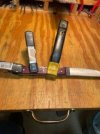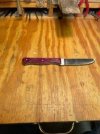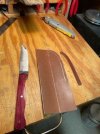I used a ball mic and measured the inside of the barrel it miced .260 so .004 smaller then the bullet diameter which is in spec. I measured the chamber to the lands it measured 2.246 the ojive on the factory rounds measure 2. 184 so that isn't bad either.
-
If you are being asked to change your password, and unsure how to do it, follow these instructions. Click here
You are using an out of date browser. It may not display this or other websites correctly.
You should upgrade or use an alternative browser.
You should upgrade or use an alternative browser.
Ramblings and Such From Hunting Coyote
- Thread starter DSheetz
- Start date
 Help Support Long Range Hunting Forum
Help Support Long Range Hunting Forum
Straight Shooter
Well-Known Member
Dave, I can take mine out of its stock and put it back in the v blocks and it will be pretty much right on.It has some vee blocks inlayed in the stock that the action is supposed to bed them together they were not doing it so well and the front sling swivel stud was too long as well kind of like setting the barrel on a ball bearing. I will take it back to the bench tomorrow and see what it does then. If it doesn't run at least a moa group, I will start the warranty process, or buy a new laminate stock and steel bottom metal.
Mine rocks back and forth on the front vee block so that block is quite a bit higher than the back one by at least .050 so I am thinking that puts a ton of stress on the action. One of the things that I will do is to torque the rear action bolt down first and see what that does with the front action bolt just snug shoot a group then torque the front and have the rear bolt just snug and shoot a group.
It likes to have the front action screw torqued to 70-inch pounds and the rear one only snug I think a good bedding job will take care of it. The Hornady 95 grain factory loads are doing good now 3/4" now to try the 120's and 140's. I will get my bedding stuff out in a couple of days and see how it works out.
Good to hear you're at least headed in the right direction now. I had zero doubt you would find the issue. At least it seems to be a somewhat simple one with an easy cure. How are those stocks put together? Pillars, bedding block, anything at all?
The action is machined in two places for a Vee block to fit in it that is fitted into the stock, so it actually has two bedding blocks. The bottom of the action is round other than that and has a barrel nut holding the barrel on it similar to an AR or a Savage. This stock is rounded for the action the front vee block is set higher than it probably should be so that the action rocks on it and then if I tighten both of the action bolts it binds the action and the barrel rubs on the right-hand side lower in the forearm of the stock. All in all, it's a pretty good idea when all things are set up right, this one, it appears, just happens not to be as it should be.
My Jack Russell (Walt) and I went out the last couple of days. We covered around 20,000 acres and found one set of fox tracks, an old bobcat scat pile that was white it was so old, we didn't see any rabbits, only five mule deer doe's no yearlings, maybe 150 head of antelope with just a few small bucks. there were some mouse and packrat tracks, no skunk, rabbit or other small mammal tracks. It's weird out there this year. It's supposed to be rainy for the next several days so we will get out after it stops and dries out some to check other places as well.
windypants
Well-Known Member
Dave, I've been watching that den up the valley and only once in the last week have I seen a coyote there. It went into the den not long before dark. I keep thinking that if she's got pups in the den I should be seeing her mate coming and going, bringing food maybe—but nothing. Any insight?
The male isn't allowed in the den with the pups, but if she still has a mate and or helper, they will be around some place close, they will be keeping a low profile with newborn pups in the area. You may not see them, but they are close by. In my area they don't always use the same den holes as they have in the past. Here they will clean out several holes then pick one to use when the time comes, she will stay with the new pups for a few days without leaving the den at all. If she did have her pups in the same hole, they are like a dog's pups and have their eyes closed for several days, then mom will venture out, if you can remember how your female dog behaved when she had her pups that is pretty close to how a coyote does. So many times, when they first have pups, they just lay low during the day close to the den during the day and move at night to feed and drink. She might only leave the den at night and stay in with the pups during the day to let them nurse. The pups will start to venture out of the den in a couple of weeks. They will be weaned in six or eight weeks and be on food brought to them by the parents that they eat and then regurgitate for them. By that time, they will stand close to eight inches at the shoulder and be losing their puppy fur. When they are first born, they will be a deep chocolate brown and when their eyes open, they will be a bright blue. turning light tan in just a few weeks' time before they are weaned. I have often seen where the adults were just eating the soft parts of kills, lungs, liver and on young lambs or fawns just the stomach full of milk to carry back to the pups, starting at around four weeks of age. Some start earlier and some start latter. At this time, it's all about protecting the lives of the pups and stealth is how they do that.
windypants
Well-Known Member
Thanks Dave! I saw her go into a different hole than I saw them in last year, about 50 yards away. I haven't heard any vocalization's anywhere in the area lately, but this is far enough away that I won't hear much when they do start talking.
You are welcome, they will go nearly completely quiet in my area for a couple of weeks after the pups are born to me it's just part of the way that they protect the newborn pups. Pretty soon in the mornings, at the right time you can hear the male telling the female that he is coming home in the morning, but it will only be one howl and she will let him know, with one howl that she heard him and it's okay to come on in. When I was younger, I could hear them from a couple of miles away. They will do these two or three times with her staying close to the den but normally from a higher place so she can see the den and the incoming male as well as any other thing that might be a threat. Then when they are together, they will do their kiyis and sniffing each other, their hugs and handshakes, he will go find a place to lay and watch the den hole while she goes to eat and drink. I have had a hard time getting them to say anything at this time of the year even with howls to them, they just kind of show up and sit or lay down to watch the den and me maybe even out a couple miles out from me. If I am right at the den, 300 yards or closer with howls they do the decoy act most of the time. I have seen birds, deer, antelope do the same kind of thing, it's a built-in survival thing, I would even do it for my kids or grandkids if needed. With coyotes they blend in well and I have at times seen them curled up at the base of sagebrush or other plants where you had a hard time seeing them. I've even seen red fox vixens laying in close to yucca plants where you could only get just a slight glimpse of them. For most of us it takes time for us to train ourselves to see them, that's where the thermals could play a part in your learning to find them. It's an art and the challenge of it is what keeps it interesting!
With the country I live in being so open I get the opportunity to see a lot of coyote behaviors that people living in brushy country can't get to see but I have heard them doing the same kind of decoying close to the den in southern Indiana where it was brushy or had taller farm crops as well as seeing them just sitting or lying and watching me when it wasn't green and I could see into the timber and fields.
I am trying to figure out how to do this ! The first picture is the fit up of the scales and brass rivets, the second is of the scales and rivets epoxied in place with the rivet heads set. The third is starting to make the sheath.


